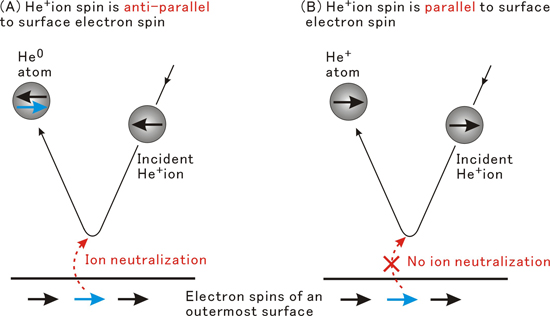Composite Analysis of “Spin” and “Structure” of Outermost Surfaces for the First Time
Development of Next-Generation Magnetic Devices by New Ion Beam Technique
2011.10.19
(2011.11.01 Update)
National Institute for Materials Science
Japan Science and Technology Agency
The National Institute for Materials Science succeeded for the first time in the world in composite analysis of electron spin, elemental composition, and atomic position of outermost surfaces.
Abstract
- Dr. Taku Suzuki, a Principal Researcher in the Ceramics Chemistry Group, Optical and Electronic Materials Unit, Dr. Shunichi Hishita, Group Leader of the same Group, and Dr. Yasushi Yamauchi, Group Leader of the Spin Characterization Group, Nano Characterization Unit, of the National Institute for Materials Science (President: Sukekatsu Ushioda) succeeded for the first time in the world in composite analysis of electron spin, elemental composition, and atomic position of outermost surfaces.
- In addition to charge, electrons possess a property like that of magnets, which is termed “spin.” Devices which employ both charge and spin are called spintronics devices. Because spintronics devices are expected to realize far higher performance than the existing devices which only use charge (i.e., electronics), development of spintronic devices is being promoted in countries around the world.
- The key to the development of spintronics is analysis of “spin” and “structure”, which is related to elemental composition and atomic position, at the outermost surface (first atomic layer at the surface). Of the two, analysis of spin is extremely difficult even with the most advanced analytical techniques. The solution of this problem is an important issue in the development of spintronics.
- A potential solution to this problem is a new ion beam called the “spin-polarized 4He+ ion beam,” which is considered to interact only with spin at the outermost surface. Composite analysis of spin and structure of outermost surfaces is expected to be possible by utilizing this interaction. In 2007, the NIMS researchers had succeeded in generation of a spin-polarized 4He+ ion beam with the world’s highest beam performance index (beam polarization). However, elucidation of this interaction (spin orbit coupling) was a key challenge for realizing the desired composite analysis.
- In this research, the NIMS group conducted systematic experiments in which various target atoms were impacted with polarized 4He+ ions. A theoretical model was then constructed based on a detailed analysis of the experimental data obtained in that work, and the spin orbit coupling interaction was successfully elucidated.
- As composite analysis of spin and structure of outermost surfaces is now easily possible using a comparatively small-scale device as a result of this research, dramatic progress in spintronics development is expected in the future.
- The results of this research will be announced in the on-line edition of the scientific journal of the American Physical Society, Physical Review Letters of October 18, 2011, and will be carried in the print version published on October 21, 2011 (US Eastern Standard Time). This research was carried out as part of the development topic “Development of spin-polarized ion scattering spectroscopy” (Team Leader: Taku Suzuki) in the Research Results Development Project, “Development of Systems and Technology for Advanced Measurement and Analysis” of the Japan Science and Technology Agency (JST).

Fig : Diagram showing the principle of spin analysis of outermost surfaces using the spin-polarized 4He+ ion beam. When He+ ions are scattered at a surface, electrons are captured by He+ at the outermost surface and the ions become He atoms (ion neutralization). However, the occurrence of neutralization is limited to cases where the spin orientations of the He+ ion and the electrons of the outermost surface are anti-parallel (Pauli exclusion principle). In (A), the He+ ion is neutralized, but in contrast, in (B), neutralization does not occur. In other words, because neutralization depends on the spin of the outermost surface electrons, the electron spin of the outermost surface can be analyzed by measuring the He+ ions which are scattered without undergoing ion neutralization.